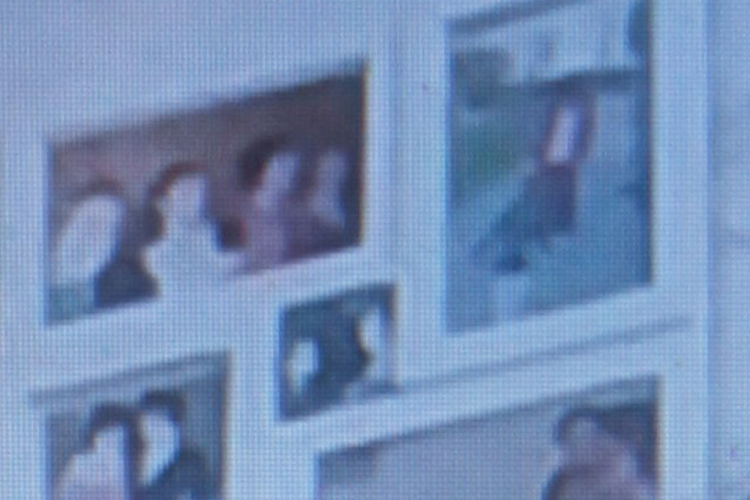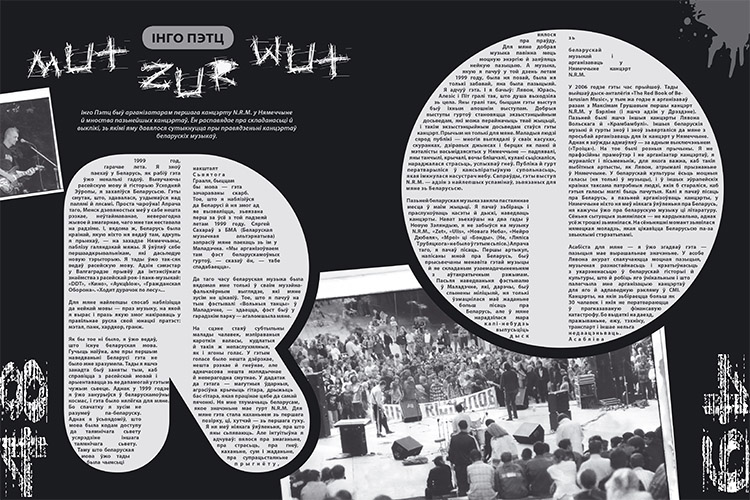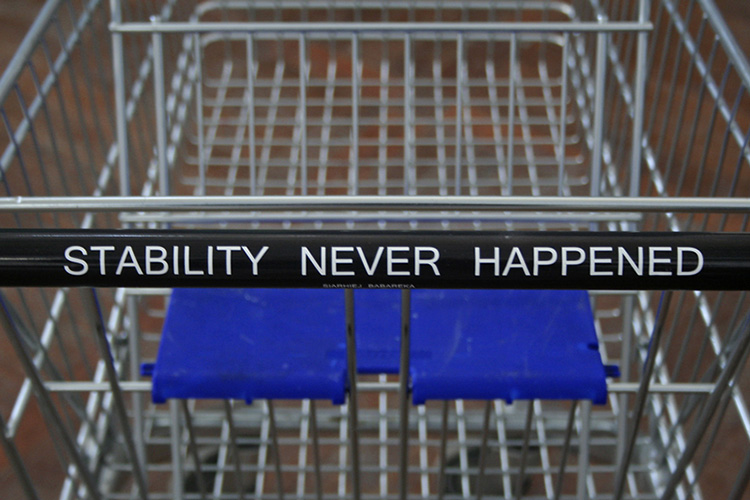
Аўтар: Volha Bubić, 05/08/2015 | ART project
WHAT RUSLAN VAŠKIEVIČ DOES NOT REGARD
pARTisan #27’2015
In the novel «What I Loved» which attempts to give interpretation to a contemporary artist’s creativity, the American writer Siri Hustvedt comes to the conclusion that any painting starts to exist only when observed by the viewer. «Any time including a viewer’s shadow into the composition, the artist emphasizes the space between the viewer and the painting, because it is there where a real action occurs, — Siri writes. — …But the space, which it takes at that moment, also belongs to the painter».
The American novelist’s reflections find their practical application in a project which seems very unusual for Belarus — Ruslan Vaškievič’s (Ruslan Vashkevich) project-painting has been named in the local mass media a travelling one.

Ruslan Vaškievič «Regarding Nothing»
Actually, the work under the phenomenologically resonating title «Regarding Nothing», according to its author, has witnessed much more than some people have during their lives. Whereas the concept encoded in the image with four figures appears to move much further beyond the limits of the traditional perception of an object of art.
The route of the travelling paintings of Rusłan Vaškievič goes through various locations meaningful for a human life description. In his interviews the artists explains: «The point is that the object where the attention of the painting’s characters is directed at is missing. I have hidden the most important thing. […] Any object that gets into the sight of the painted characters is charged with their energy, it becomes a part of the picture. […] When I realized what had happened, I started thinking of how to proceed. The picture itself began giving me prompts and sometimes even dictating. And this is where I got my courage. I realized that the picture was suitable neither for a museum, not for a wall in the bedroom of some wealthy collector. I guessed that the whole world was for it and it needed to set off on a journey. Not to show it to the world, but to show the world — to it. To look at what is happening through the eyes of the painted characters, to try to honestly see what it really is, and not what is said about it…
I asked myself a question: what can I show to my painting? What places can there be? It occurred important to me to describe a human life’s cycle evolving in the urban setting — from the moment of birth to the death, from church to prison, from a shopping mall as the embodiment of the idea of the consumption’s victory to the dump, where this idea comes to the apocalyptic state. Thus, I began to take my picture into different places».
However, the project’s secret and power lie far from a mere fixation of the locations where the painter managed to photograph the painting using the methods of either pressure or persuasion, but in the way how its thoroughly elaborated content works with the ever-changing context, defining the spectator’s vision and creating amazing meaningful revelations.

Ruslan Vaškievič «Regarding Nothing»
Since it is exactly this space, the gap between the picture and the viewer turns out to be the protagonist that fills in the intentional semantic gap that ranges from shot to shot.
Speaking about contemporary art, the Russian philosopher and culturologist Elena Petrovskaya mentions among its characteristics the reinvention of means of expression. She shares Rosalind Krauss’ opinion that the contemporary artist today has to reinvent them, subordinating the tools to his/her own idea, being free to mix and borrow them from the areas that may be even very far from art. If to analyze in this light Rusłan Vaškievič’s project, we come to the conclusion that «Regarding Nothing», due to the importance of the dynamics of its movements and the role of the interaction between the space of the painting and the viewer, can with certainty be called a performance.
The simplest definition of performance as a form of contemporary art comprises an event in which an artist behaves in a particular way in a particular space and time. Any situation can be named a performance if there are four basic elements present: time, space, the artist’s body and the interaction between the artist and the audience. In Rusłan Vaškievič’s project all these components can be traced. In every shot that documents the picture’s movement, the elements of time and place are easily decoded, whereas the canvas itself plays the role of the specific artist’s body. The interaction between the artist and the viewer obviously bears the biggest semantic charge in the given act of performance. Studying every photography in particular, we, as external observers, decode the reactions of the painted figures which turn out to differ significantly in each case being placed in scenes that have been purposefully selected by the artist: a dump, a night club, a church, a morgue and others. The reactions of the depicted characters become a means of expressing of a wide range of emotions for us to interpret. On their faces we find dispraise or an angry reproach, pity or an undisguised sympathy, surprise or contempt.
Analyzing Rusłan Vaškievič’s work, the Belarusian philosopher and culturologist Almira Usmanova writes: «Changing the angles, cropping the observable world in different ways, suggesting an unexpected „viewpoint“, constructing the imaginary world beyond the picture frame, the artist reminds us that art is always the art of seeing». However, we need to keep in mind that the very act of seeing activated by the artist is determined first of all by the figure of the viewer him/herself, that is by ourselves, or namely by those clichés, social and cultural stereotypical ideas, which are stimulated in us by the photographs of the places suggested by the artist.
In this respect the painting is just a trigger which launches in us the mechanism of the emotional seeing of the given context.

Ruslan Vaškievič «Regarding Nothing»
Another characteristic feature of contemporary art that can be discerned in the work «Regarding Nothing» is its interventional potential. Taking the canvas out of the studio walls, the artist is a kind of testing the strength; he is checking the readiness of various social settings to be transformed, even for a few minutes of the actual shooting of the object, into an exhibition hall. The unshakable authority of the museum as a single point of contact with the art is questioned. Simultaneously with the change of the external scenery, the substitution of the viewing direction occurs:
now the painting itself, alongside with the audience, moves across the halls of the imaginary museum as big as the world.
It should be noted that the theme of the problematization of museum borders is not new in Rusłan Vaškievič’s works. In 2011, the National Art Museum became a field for a creative experiment for strength, where more than 20 works of the author united under the ironic name «Museum» were exhibited. It is already then, three years ago, the key word «intervention» was pronounced by the artist himself, who noted that the project should not be seen as equal with the museum in its traditional understanding. «It is a rehearsal of the museum, — Rusłan Vaškievič commented, — a model of the artistic intervention, disguised in the golden frame of „law“ in 1: 1 scale». But, unlike the changeling, started in the project «Regarding Nothing», here a kind of subversion was happening from the inside: agreeing on a given authoritarian and pretentious context of the country’s most prestigious areas, the artist makes it play by his own rules, filling the halls with witty interpretations of familiar masterpieces of classical art easily recognized by the public.
The curator of the exhibition «Museum» Almira Usmanova explains that by means of his exposition the artists suggests to reflect on the museum of a totally different kind, as about a place far from its perception in terms of «bastion of «cultural respectability», «a sacred space that stores masterpieces and where the eras quietly talk with one another». Rusłan Vaškievič’s «Museum» not only reveals the author’s playful perception of the dialogue, the interaction of the epochs, names and images, but also creates an open provocation targeted at Pillars, Canons and Museums.
Thus, the project «Regarding Nothing» turns out to be a discovery of another aspect of the incredibly active and always ironic artist Rusłan Vaškievič, being quite pleasant for the Belarusian artistic environment. Setting the tone for the game, the travelling panting makes the viewers face questions that go far beyond the ordinary observation of the objects of art at museums and galleries. The interaction between the painting and various urban settings initiated by the project’s experimental format, makes us think about the role of the context topical in our today’s environment, which happens to be so powerful in producing an impact on our perception modality. And here not only the platforms of the exposition of the objects of art are meant, although, undoubtedly, in the specific situation of the connotations of state and private museums and galleries in Belarus this issue is also rather topical. In the focus of the artist’s reflections there is a problem of objectivity, of the genuine nature of any gaze, directed into the world, the question of the possibility of being free from clichés and stereotypes today.

Ruslan Vaškievič «Regarding Nothing»
And thus the return of the travelling painting into the museum walls seems to be not accidental. There the space between it and the viewer remains vacant, as if offering each of the visitors to participate in the ongoing performance. But what if one day under the scrutinizing eye of «Regarding Nothing» you will suddenly find yourself?
Volha Bubič
Photo © Ruslan Vaškievič
Opinions of authors do not always reflect the views of pARTisan. If you note any errors, please contact us right away.





